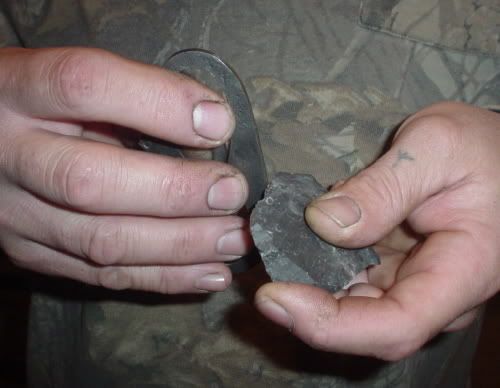Here is my original posting on natural tinders.
...and, to clarify..Jeff was referring to tinder fungus with old fashioned flint and steel, not fire pistons.
Natural Tinders for Flint and Steel
Fire without Charcloth
.
Jeff Wagner
Feb 2006
The use of charcloth in primitive fire starting represents something of a chicken and egg conundrum. In order to make charcloth, one first needs fire
and to make fire most primitive pyros use charcloth. So
where do you start and are there alterative ways to get a cook fire ablaze with flint and steel? You bet! Actually, the use of charred cloth is a relatively modern development and one that requires the availability of woven cotton fabric.
Cloth being a rather valuable commodity on the frontier, the Missus Long Hunters of yesterday took a rather dim view of smoldering the family duds just to make something that catches a spark. Thankfully, nature provides a number of tinders that will catch and propagate a spark from a flint striker - but they need to be handled a bit differently from the eyebrow singing whoosh of tow and charcloth. ( Note - There are natural tinders that perform after chemical alteration and special treatments, however to maintain the natural flavor of this article we will focus only on those requiring no special treatment other than drying. )
With charcloth, the fiber nest is blown into flame using the heat given off directly by the charcloth. Most of the natural tinders develop an outer layer of ash as they burn that insulates the fiber nest from the direct heat of the coal and inhibits direct ignition of the fibers in other words
no flame. Natural tinders perform best when they are combined with a coal extender and natural fibers. ( Please note that while jute, hemp, sisal and other commercially available cordage fibers commonly used in primitive fire making are natural, they do not carry a coal well nor do they grow on the North American continent.) Coal extenders cause the tiny spark from the striker to grow and expand producing more heat and more heat until combustion temperature is reached. Common examples of coal extenders include certain types of fungi including hoof fungus ( Fomes Fomentarious ) True tinder fungus (Inonotus Obliquus) piths from weed stalks such as mullein, the shredded inner bark of trees such as cedar and plain ordinary punk or rotten wood. Punk, sometimes called touch wood, will propagate a coal as well as tinder fungus. Once the punk is touch by the glowing ember it will spread until the entire piece becomes a large smoldering coal thats difficult to extinguish.
Natural tinders
Inonotus obliquus Fomes fomentarius
Mullein Milkweed pod
OK, so weve been out foraging and have our coal extender ready. Now what? We need something to take the place of the charcloth.
If you happen to live in an area within the range of white or yellow birch trees you will soon learn to appreciate the qualities of true tinder fungus ( Inonotus Obliquus ). It is an amazing natural tinder. Simply place a pea sized chunk on top the flint as you would charcloth and strike as you normally would. Putting the tinder on top on the flint is important. Many people make sparks by striking the steel with the flint and driving the sparks downward. This method work well with charcloth and powdered tinder ( something well discuss later on ) however directing the sparks to land on and catch on a tiny piece of fungus can be quite frustrating. To overcome this, we place the fungus on top of the flint and strike the flint with the steel. This causes the sparks to fly up and forward, directly into the tinder fungus. The very short gap traveled by the spark enables it to land sooner and hotter, thereby increasing the chances of it catching in the tinder. Once the spark catches it will spread and consume the fungus so its important to quickly transfer the spreading coal to a larger piece of fungus or other coal extender.
Spark from steel has ignited Milkweed pod
Note - While tinder fungus will easily catch and propagate a spark and once ignited it is extremely difficult to extinguish. Just light a small piece and try stomping it out in your moccasins the next camp over yonder will think youre calling for rain
.
Shredded cedar bark works extremely well with tinder fungus. Prior to lighting the fungus, take some strips of dry cedar bark and pound them with a rock or large tree limb. Pull out enough fiber to form a compact ball about an inch or two in diameter. Roll this between the palms briskly to separate the fibers then fluff slightly. Flatten the ball and fold in half to make a pocket. Now light the fungus tinder and place the coal into the pocket you made in the bark. Fold the nest around the ember and with your back to the wind, blow gently on the ember until the fiber nest begins to smoke heavily and starts to make a roaring sound. Be prepared when you hear this sound, as the nest will suddenly burst into flame. Usually three to four long sustained breaths is usually all it takes. Gently feed the flaming fiber nest with savings or dry twigs, gradually building up to larger pieces blowing as necessary to maintain flames.
Hint - To ignite flames, the fiber nest must be sufficiently compacted such that the fibers are in contact and able to propagate the ember. If too loosely packed the ember may die before achieving flames. The nest should still be loose enough however for air to circulate.
If natural fiber is not available in your area try wood punk. Dry punk from dead trees carries a coal very well. Three or four pieces of punk, placed in contact with one another, can be blown into flame all by themselves. If there is a slight breeze blowing, this method can be nearly self-igniting. Just expose the coal to the wind and let do the work. You can also place very fine wood shavings, twigs, birch bark or other combustible material on the punk to enhance the development of flames.
Another very effective natural material for catching a spark is milkweed pod but not the whole outer pod. The part we want is the slender, puffy structure that remains in the pod after the down has dispersed. These are easy to find in the fall after the pods have opened and their seeds have scattered to the winds. Simply tear off one end to create a ragged edge and place this on the flint as you would charcloth. Once it catches, quickly transfer the spreading coal to your coal extender. You will have to act quickly as this one has a short burn time.
Next comes mullein pith. The trick to getting a spark to catch in this weed-stem pith is to slice it very thinly with a sharp knife. You want to present the finest, most delicate edge possible to the spark and you want a spark that clings and lingers just a bit on the edge of your flint. This allows for longer contact time with the mullein pith. When using more challenging tinders it is helpful to change our way of thinking from that of catching a flying spark to transferring the heat from a hot glowing shred of metal to the tinder by direct contact. When the spark catches, again use the tiny glowing coal to ignite a larger coal extender.
Lastly, ordinary wood punk or touch wood ( rotten, decaying wood ) provides an extremely useful natural tinder. While it is more difficult to use with flint and steel its abundance makes it worth the effort required in learning to using it successfully. Not only will it catch a spark but several chunks placed in direct contact with one another can be blown into flame without need for shredded bark or fiber. This can be extremely important to know in an area where suitable fiber is not available. Punk exists everywhere that trees grow and even in a rainstorm it is usually possible to obtain suitable punk from the interior of a standing dead tree trunk that has been sheltered from the elements.
You can follow the basic guidelines above placing the punk on top of the flint, however small pieces of punk tend to fragment easily. As an alternate approach, you can rub the punk between the palms, grinding it up into a fine powder. Do this over a large leaf so you can catch and later move the dust pile created. When using a tinder pile you reverse the set up and strike the steel with a downward blow from the flint driving the sparks down into the dust pile. Punk can be stubborn to catch and several strikes may be needed. Once a spark has caught, fan it gently with your hand to expand the coal. Blowing on it too hard may scatter the dust pile
and your coal. When the coal is burning well, scoop under it with the tip of a knife to lift it out of the dust pile and transfer it in your fiber bundle or punk.
Note: Save the remaining punk dust! A small metal tin makes a great place to store your remaining punk dust. And, if you allow do not remove all of the coal but allow it to propagate a bit in the dust, the charred dust will catch a spark much easier next time. Simply place the lid on the tin when its time to extinguish the smoldering punk.
For more information, please visit Wilderness Solutions at
www.wildersol.com
or us call 585 305-3017.


